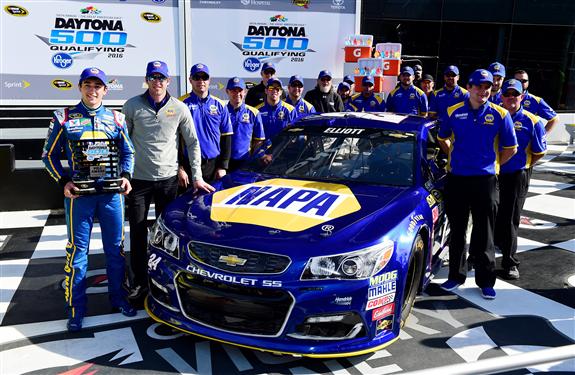One year ago, the qualifying procedure for the Daytona 500 could not be summed up without using the word “cluster” in the description. You, the readers, can decide how to finish that idea.
A year ago, the qualifying procedure meant group qualifying, and that made an issue for many teams because wrecks took out many good cars, and ultimately made the entire endeavor one that needed to be forgotten. Drivers were angry, fans were angry, and the entire procedure was eventually scrapped for something better.
This year, NASCAR brought back the single-car qualifying for the Daytona 500, but also implemented the plate qualifying procedures to make the single laps matter.
The teams that are entered into the race have the opportunity to make their qualifying run. At the end of that round of qualifying, the top-12 will then come back in a second round. The order of the initial round of qualifying is based on practice speeds from the prior day. For the second round, the order is in the reverse order of how the first round finished.
As is done in previous years, the final qualifying only sets the front row for the race. Positions 3-40 are then set based on the Can-Am Duels that are run on Thursday evening.
It means for the teams that qualifying isn’t based on just having the best drafting partner at the right time. It’s back to being about a team effort in getting a machine fast enough to run one lap, and then turn around to get it ready to run another 200 to start the season.
The biggest surprise, which even those in the FOX booth couldn’t quite believe, was who ended up on the pole.
A year ago, to start out his final season, it was Jeff Gordon winning the pole for the Daytona 500. Now, he’s standing high above the track alongside Darrell Waltrip and Mike Joy, calling the race. On Sunday, he saw his former number, with an entirely new look and sponsor, get back to the lead of the pack in the final round to claim the 2016 pole for the Daytona 500.
What makes it even more incredible is that NASCAR had to change the award name, along with the banners in victory lane, in order to present the pole award.
The reason: the winner of the pole is under age.
NASCAR’s pole award is sponsored by Coors Light, but this year, it had to be changed to the “21 Means 21” pole award. Pole winner Chase Elliott, the son of 1988 Cup champion Bill Elliott, is only 20 years old, and is still less than 10 months until he legally can drink. So, the decal going on the car suddenly changes, the background for photos changes, and even “Miss Coors Light” must take a back seat and obey the law by not posing in the photos.
Elliott is now the youngest driver to win the pole for the biggest race of the year, keeping a trend of monumental pole awards going. Since this column started, we’ve seen the first woman take the pole for this race, a driver making his final start in the big race start first, and now we have a first-time Daytona 500 driver earn his first pole.
Not a bad record for the No. 24.
Elliott is guaranteed to start on pole next Sunday, but he must be careful in all the practice sessions and also his duel race on Thursday. If he is involved in a wreck, he may have the right of earning the pole, but once he goes to the backup car, he goes to the back of the field. That is a risk that often may be too great to go after, especially after a monumental moment such as this.
The Can-Am Duels at Daytona go green beginning at 7 p.m. on Thursday
QUALIFYING NOTES
- The No. 78 Toyota of Martin Truex Jr. will start from the back in his duel race as he did not post a qualifying time. NASCAR officials pulled the car from pit road and to the template area used for inspection, finding an issue with the right-side roof flap, specifically where it sat on the roof when not deployed. No penalties aside from starting at the rear for the duel race have been announced, but could come at the weekly competition meeting on Tuesday.
- The No. 4 and No. 14 Chevrolet of Kevin Harvick and Brian Vickers, subbing in for the injured Tony Stewart, both failed post-qualifying inspection. Both cars were found to have track bars that were not in compliance with NASCAR. The qualifying times for Harvick and Vickers were disallowed, and both will start at the rear of their respective duel races.
